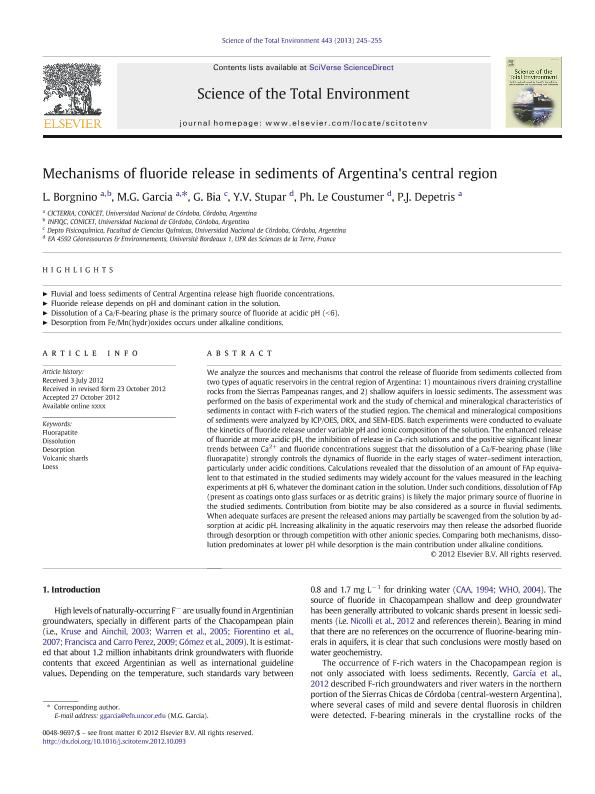Artículo
Mechanisms of fluoride release in sediments of Argentina's central region
Borgnino Bianchi, Laura Carolina ; Garcia, Maria Gabriela
; Garcia, Maria Gabriela ; Bia, Gonzalo Luis
; Bia, Gonzalo Luis ; Stupar, Y. V.; Le Coustumer, Ph.; Depetris Gallino, Pedro Jose
; Stupar, Y. V.; Le Coustumer, Ph.; Depetris Gallino, Pedro Jose
 ; Garcia, Maria Gabriela
; Garcia, Maria Gabriela ; Bia, Gonzalo Luis
; Bia, Gonzalo Luis ; Stupar, Y. V.; Le Coustumer, Ph.; Depetris Gallino, Pedro Jose
; Stupar, Y. V.; Le Coustumer, Ph.; Depetris Gallino, Pedro Jose
Fecha de publicación:
11/2012
Editorial:
Elsevier Science
Revista:
Science of the Total Environment
ISSN:
0048-9697
Idioma:
Inglés
Tipo de recurso:
Artículo publicado
Clasificación temática:
Resumen
We analyze the sources and mechanisms that control the release of fluoride from sediments collected from two types of aquatic reservoirs in the central region of Argentina: 1) mountainous rivers draining crystalline rocks from the Sierras Pampeanas ranges, and 2) shallow aquifers in loessic sediments. The assessment was performed on the basis of experimental work and the study of chemical and mineralogical characteristics of sediments in contact with F-rich waters of the studied region. The chemical and mineralogical compositions of sediments were analyzed by ICP/OES, DRX, and SEM-EDS. Batch experiments were conducted to evaluate the kinetics of fluoride release under variable pH and ionic composition of the solution. The enhanced release of fluoride at more acidic pH, the inhibition of release in Ca-rich solutions and the positive significant linear trends between Ca2+ and fluoride concentrations suggest that the dissolution of a Ca/F-bearing phase (like fluorapatite) strongly controls the dynamics of fluoride in the early stages of water–sediment interaction, particularly under acidic conditions. Calculations revealed that the dissolution of an amount of FAp equivalent to that estimated in the studied sediments may widely account for the values measured in the leaching experiments at pH 6, whatever the dominant cation in the solution. Under such conditions, dissolution of FAp (present as coatings onto glass surfaces or as detritic grains) is likely the major primary source of fluorine in the studied sediments. Contribution from biotite may be also considered as a source in fluvial sediments. When adequate surfaces are present the released anions may partially be scavenged from the solution by adsorption at acidic pH. Increasing alkalinity in the aquatic reservoirs may then release the adsorbed fluoride through desorption or through competition with other anionic species. Comparing both mechanisms, dissolution predominates at lower pH while desorption is the main contribution under alkaline conditions.
Palabras clave:
Fluorapatite
,
Dissolution
,
Desorption
,
Volcani Shards
Archivos asociados
Licencia
Identificadores
Colecciones
Articulos(CICTERRA)
Articulos de CENTRO DE INVEST.EN CS.DE LA TIERRA
Articulos de CENTRO DE INVEST.EN CS.DE LA TIERRA
Articulos(INFIQC)
Articulos de INST.DE INVESTIGACIONES EN FISICO- QUIMICA DE CORDOBA
Articulos de INST.DE INVESTIGACIONES EN FISICO- QUIMICA DE CORDOBA
Citación
Borgnino Bianchi, Laura Carolina; Garcia, Maria Gabriela; Bia, Gonzalo Luis; Stupar, Y. V.; Le Coustumer, Ph.; et al.; Mechanisms of fluoride release in sediments of Argentina's central region; Elsevier Science; Science of the Total Environment; 443; 11-2012; 245-255
Compartir
Altmétricas



